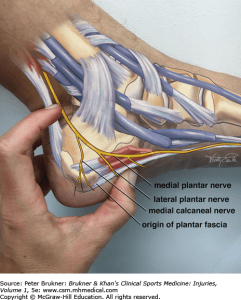MEDIAL HEEL PAIN – WHAT IS IT?
The Cause of Medial Heel Pain
As sports podiatrists we are commonly asked the question, what is causing my medial heel pain. Truthfully, there is more than one cause of pain on the medial side of the heel, but the most common would be plantar fasciitis. Plantar fasciitis is a condition associated with inflammatory change within the fascia under the sole of the foot. Usually, the heel pain overrides pain through the arch of the foot, more distally. If you are suffering with medial heel pain, then you will probably notice that the pain is very apparent first thing in the morning when your foot hits the floor. This is very common and very typical of plantar fasciitis. The heel pain is also usually present when standing up and walking from a seated position. Therefore, after you have been driving or sitting down for dinner you may feel discomfort as you begin to move.

Another cause of medial heel pain is thought to be Baxter’s nerve impingement. The entrapment of the nerve on the medial side of the heel is thought to cause a referred pain similar to that of plantar fasciitis. Imaging using MRI is used for in the circumstances.
Another cause of media heel pain is tibial nerve entrapment through the tarsal tunnel. This is less common than the medial heel pain associated with plantar fasciitis. Again, imaging with MRI can be useful in diagnosing tarsal tunnel syndrome. On occasions, surgical intervention is required in order to release the nerve in the tarsal tunnel, and to relieve the medial heel pain.
Plantar Fasciitis – What Causes Medial Heel Pain?
The cause of medial heel pain from plantar fasciitis is multifactorial. Weight gain, an increase in body weight, an increase in physical activity over a short period of time, tightness through the muscles in the lower leg and biomechanical anomalies are just a few of the common causes of plantar fasciitis. Other things such as poor choice of footwear can also lead to medial heal pain and plantar fasciitis.
Treatment for Medial Heal Pain
The selected treatment for medial heel pain will depend on the diagnosis. There are several treatments for the main or the most common condition, plantar fasciitis. Shockwave therapy is a relatively new and a very successful way of treating medial heel pain when plantar fasciitis is associated. Shockwave therapy stimulates blood flow and helps with the turnover of new healthy cells. There is an analgesic side effect with the treatment although this is not the main reason for carrying out the treatment. Shockwave therapy is normally carried out in the clinic once a week and is performed at least three times and up to six times. The medial heal pain usually dissipates slightly after each session.
Other treatment options for medial heal pain coming from plantar fasciitis are things such as orthotic therapy. A firm orthotic shaped in such a way that it touches and holds the plantar fascia, without pressing against it and attempting to raise the arch higher than its resting height, is a great way of unloading the plantar fascia. Plantar heel pain, medial heal pain and other foot ailments will ordinarily feel much better with the use of such an orthotic. At the Sydney heel pain clinic, the podiatrists use 3D technology to capture the shape of the patient’s foot and a 3D printer is used to manufacture these devices. Not all orthotics are made equally, and some generic and even prescription orthotics fail when not designed properly. The sports Podiatrist becomes the architect, whereby they select the material, the shape, the height, the width of the orthotics and which modifications or deflections should be added.
If a patient has excruciating medial heal pain and they are unable to walk without severe compensation then the use of an immobilisation boot is definitely appropriate. There are several types of immobilisation boots available to practitioners, but the Sydney heel pain Clinic only use a Swiss branded device which has been proven to be more successful than any others.
At the Sydney Heel Pain Clinic, all patients will go through a biomechanical assessment. Following this assessment on a treadmill using 3D digital software, the podiatrist is able to detect biomechanical anomalies and frequently is able to determine what the cause of the medial heal pain was. Once the assessment has been completed and the data analysed, the podiatrist can simply recommend very specific shoe models or footwear types that should be used in order to treat the condition. Sometimes, the medial heal pain will subside with a simple change in footwear.
More often than not, there will be some tight muscle groups affecting the foot and ankle which is prolonging the medial heal pain. The podiatrist will usually demonstrate and request specific stretching techniques in order to assist.
The Sydney Heel Pain Clinic have a mobile phone application which contains information relating to the stretching techniques in addition to other important information associated with the rehabilitation of the medial heal pain.
The information above is not strictly medical advice and if you are suffering with plantar fasciitis or any other form of medial heel pain then it is important that you seek an accurate diagnosis from a medical practitioner.
Article written by Fatemeh Abdi
Sports podiatrist
Sydney Heel Pain Clinic
Sydney Heel Pain Clinic can be contacted on 93883322 or [email protected]. The sports podiatrist treat all foot and leg pain including plantar fasciitis, Achilles Tendonitis, heel spurs. Medial heel pain, plantar heel pain, posterior heel pain and also bursitis. We are registered with all health funds and also accept care plans from your GP. Please note that there will be a gap payment for all care plan patients who are receiving treatment for plantar fasciitis and other heel pain conditions.
If you are suffering with medial heel pain and need to make an appointment you can also complete a contact form on our web site by clicking request an appointment or book online.
Written by Karl Lockett





